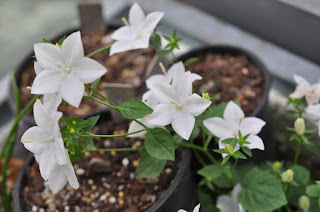Cyclamen dominate the garden.
A group planting of Cyclamen graecum and there are so many variations, leaf patterns, magenta flares on the white and pink flowers and just the pure colours. Hot and dry is the order of the day and full sun.
Seed is readily available from most of the seed exchanges.
Cyclamen graecum.
Cyclamen graecum forma album.
Cyclamen graecum.
Cyclamen graecum.
Cyclamen africanum a form flowering before the leaves appear.
Cyclamen intaminatum not as hardy as Cyclamen graecum or Cyclamen africanum.
It can be grown in our gardens but the tuba is quite small so you need to mark the area well and it is not one for full sun, it needs either filtered sun or 1-2 hours of sun at the most. As shown in an older blog, more have come into flower.
Cyclamen mirabile 'Tilebarn Nicholas' seed from Green Ice Cylamen Company. I struggle with this Cyclamen in pots I'm not sure what I do wrong probably over water. It comes from Turkey, Quercus and Pinus woodland filled with limestone and granite rocks 330-1,600 m. It would probably be better off in the garden. When raising from seed you need to sort out the truly named forms, some are better than others, as Fermi discussed at our last meeting.
I picked up in Birregurra, Victoria a book on Cyclamen A guide for gardeners, horticulturists and botanists by Christopher Grey Wilson for $8.00 recently I thought that was very reasonable.
Sternbergia lutea one of the easiest and readily available of the Sternbergia's to grow in our gardens, another sun lover.
Colchicum variegatum with the mauve-purple anthers and large open star shaped flowers.
Tricyrtis macranthopsis for the woodland from Japan, lovely heavy, waxy yellow flowers, spotted with red on the inside. Propagated by division available from Lynn's rare plants.
Campanula isophylla Alba. From Northwestern Italy in coastal limestone rock crevices near Savona
Campanula x warleyensis imported by one of our founding members Marshal Mitchell, enjoys more sunshine than a lot of our other Campanula's that we grow, it also likes a rock for its roots to grow under to keep them cool. It has had a name change to Campanula x haylodgensis 'Warley White'















No comments:
Post a Comment